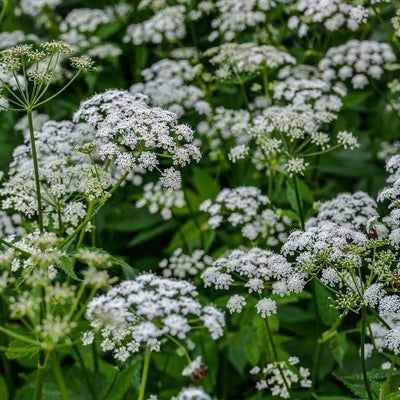
Quick facts
Ground elder’s botanical name is Aegopodium podagraria
It has many common names, including goutweed, bishop’s weed, acheweed and Jack-jump-about
Ground elder is beneficial to wildlife; it is a food plant for over 25 different species of invertebrates
Ground elder’s rhizomatous root system allows it to spread quickly
If you need to control ground elder, non-chemical methods are effective but require patience and persistence
What does ground elder look like?
New growth appears in early spring, with hollow leaf stalks bearing fresh green leaflets. Growth continues throughout spring and into summer, resulting in dense ground cover 30–60cm (1–2ft) tall.
In late spring and summer, flower stalks grow above the foliage and produce umbels of tiny white flowers. Oval seed capsules with ridges are about 4mm (1/6in) long and split to release two seeds when mature.
Underground, a shallow rhizomatous root system forms, with pale cream-coloured roots forming a dense mat.

Did you know?
Ground elder is classed as an archaeophyte, having been introduced by humans and naturalised before 1500. It is believed the Romans intentionally brought ground elder to Britain, as they valued it as a medicinal and edible plant.
Is ground elder a weed?
Ground elder is a useful plant to wildlife and people, so not all gardeners view it as a weed.
The Biological Records Centre lists numerous beetles, leaf miners, butterflies and moths that feed on ground elder, including frosted orange moths and rare swallowtail butterflies. Its carpet of leaves also provides habitat and shelter for various creatures, including ground-active invertebrates.
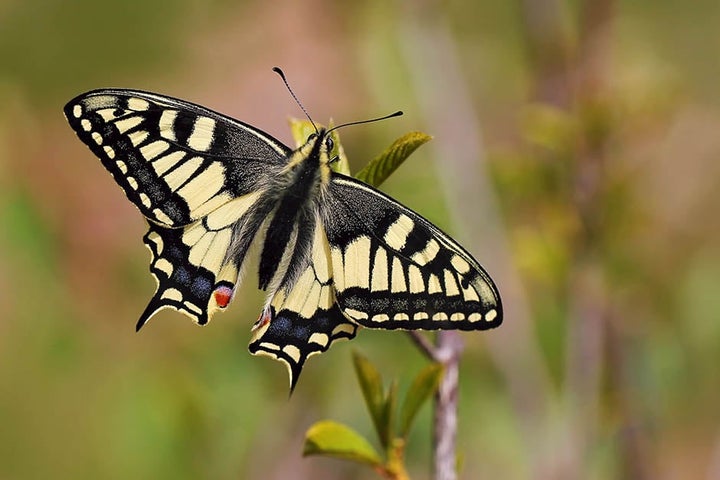
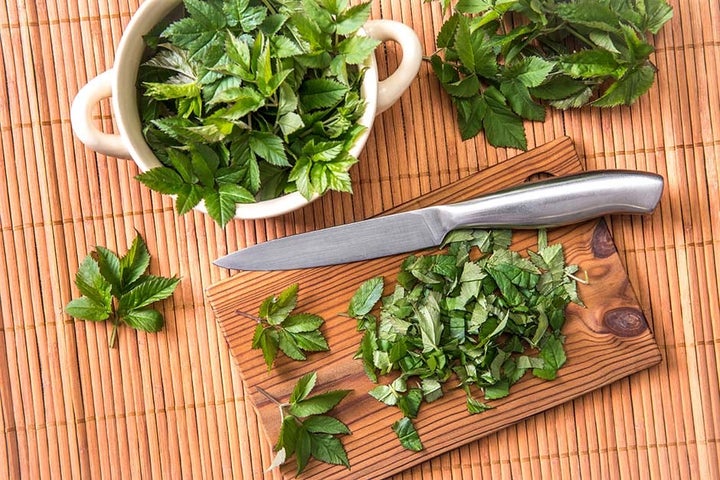
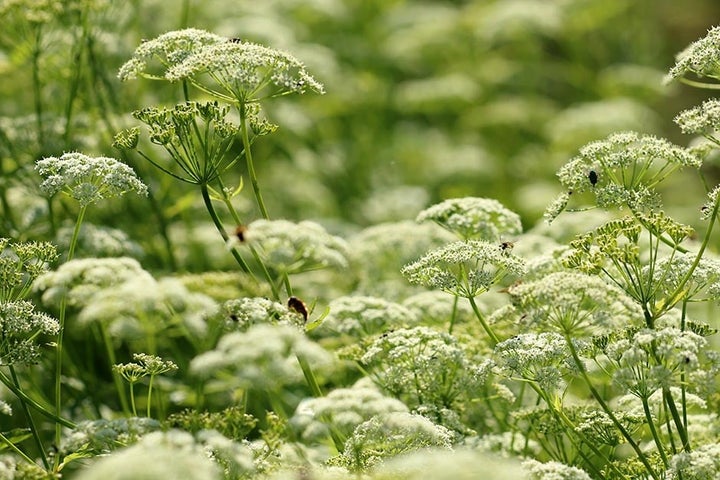
Ground elder has a long history of medicinal and edible uses. Its leaves have a tangy flavour with a hint of parsley and are a favourite of foragers, with young unfurling leaves picked for salads and slightly older leaves picked for cooking as a leafy vegetable.
Did you know?
Gout is one of the many ailments ground elder was used to treat. This gave it the common names, still in use today, of goutweed and bishop’s weed (bishops being able to afford rich diets associated with gout).
Ground elder also makes an attractive groundcover plant for wild areas, with delicate-looking umbels of tiny white flowers lasting a couple of months. A , Aegopodium podagraria 'Variegatum', is available; it is slightly less vigorous than plain green leaved ground elder.
Despite its uses, ground elder’s fast spreading roots and ability to outcompete smaller or less vigorous plants makes it unwelcome in many gardens.
What is a weed?
The term ‘weed’ describes a plant that is growing where it isn’t wanted. Weeds usually thrive in average garden conditions, reproducing and spreading easily. It is up to you to decide what you call a weed and what you choose to retain or remove.
Frequently asked questions about controlling ground elder
Here are our answers to your most common questions about dealing with ground elder:
How invasive is ground elder?
Ground elder can regenerate from small sections of rhizome (underground stems able to produce roots and shoots). New plants or soil containing fragments of rhizome can unintentionally bring ground elder into gardens. Once introduced to soil, ground elder roots spread quickly. Gardeners roots or chopping them up when digging might also unwittingly spread it. Taking care not to add roots to your home compost bins and being mindful of where you dig (and if you need to dig at all) helps to reduce their spread.
Ground elder can spread by seed, but this isn’t common, as seed is short-lived and generally doesn’t travel far from the parent plant.
Do I need to get rid of ground elder?
No – allowing ground elder to grow in a wildlife corner, on a bank or verge, at the base of a mature hedge or in a ‘wild’ shady area will attract wildlife, provide edible new shoots and give you the chance to enjoy its attractive flowers.
It is, however, a good idea to control the spread of ground elder to stop it becoming established or too abundant in parts of your garden where it might smother and outcompete other plants.
What is the easiest way to kill ground elder?
If you have ground elder growing where it is not wanted, there are several ways to control and remove it:
- Pull or cut off new growth – where it is not possible to remove ground elder roots, regular removal of new stems will suppress it, and if done repeatedly, can eventually eradicate it.
- Fork out plants – use a border fork, inserted to its full depth, to lift and remove plants with as much of the root system as possible.
- Lift border plants, clear the ground and replant – an option where ground elder is abundant in established borders and you don’t wish to leave the area bare (as below). Lift out and set aside border plants and then remove as much ground elder as possible. Before replanting, examine the rootballs of your plants carefully to remove any hidden ground elder roots. This is best done when the border plants are and less likely to suffer from root disturbance. Regularly check for regrowth from any missed ground elder and fork it out (as above) as soon as it appears.
- Smother plants – cover the ground with a layer of compostable material, such as cardboard, and then a layer about 20cm (8in) thick of organic matter, such as or wood chips. Alternatively, use a heavy grade matting. This will block light and prevent growth, causing the root system to die. Keep soil covered for a few years, topping up the mulch layer if necessary, to ensure this method is effective.
- Shade out plants – plant densely with low growing evergreen shrubs to weaken ground elder growing beneath.
- Mow regularly – if ground elder appears in a lawn, regular mowing will weaken and eventually eliminate it. Laying turf over an area containing lots of ground elder and mowing regularly should eradicate it within a few years. This is an alternative to covering the ground (as above) but gives you a useable space during the process.
- Avoid disturbing the soil – ground elder can regenerate from chopped up fragments of root/rhizome, so practise no-dig gardening and avoid , digging or rotavating the soil where it grows.
- Insert a physical barrier – to prevent the spread of ground elder into your garden from neighbouring properties, insert vertical, solid barriers at least 45cm (18in) deep into the soil along fences and other boundaries.
Although ground elder doesn’t often spread by seed, you can prevent it doing so by deadheading plants after flowering. Check around for in spring and remove them with a hand fork.
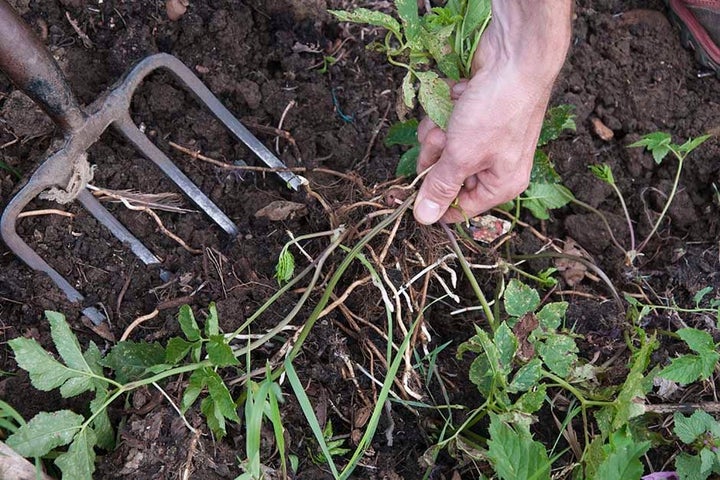
Top Tip
Don’t add ground elder roots, rhizomes or seed to your home compost bin, as it may not reach high enough temperatures to kill them. Instead, put them in your council green waste recycling bin or take them to your local recycling site.
Should I use weedkiller?
As non-chemical control methods are effective, even if time-consuming, there is no need to use weedkillers. For more information, see our page on Weeds: non-chemical controls.
Using a systemic weedkiller (sometimes recommended for ground elder control) is not a quick or easy control option. Due to the extensive roots of ground elder, numerous applications would be necessary to eradicate established plants. Using vinegar is sometimes recommended, but this is not an effective control method and we advise against using household products as weedkillers.
The RHS does not support the use of weedkillers and recommends that alternative control methods are used. However, when plants are a threat to and gardeners struggle to control them with cultural methods, targeted use of regulated weedkillers may be an option. Garden centres and large retailers selling weedkillers have trained staff who can advise on suitable products for your needs.











